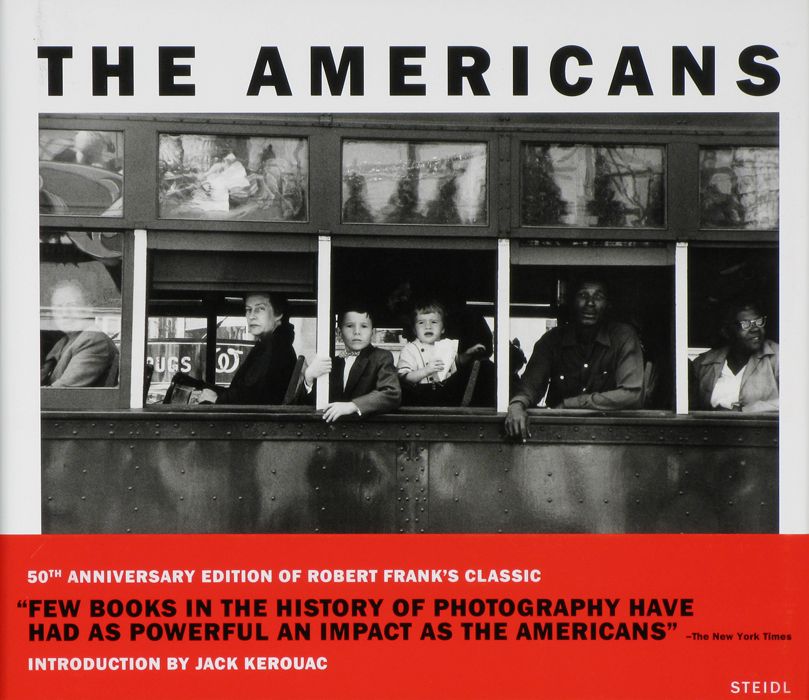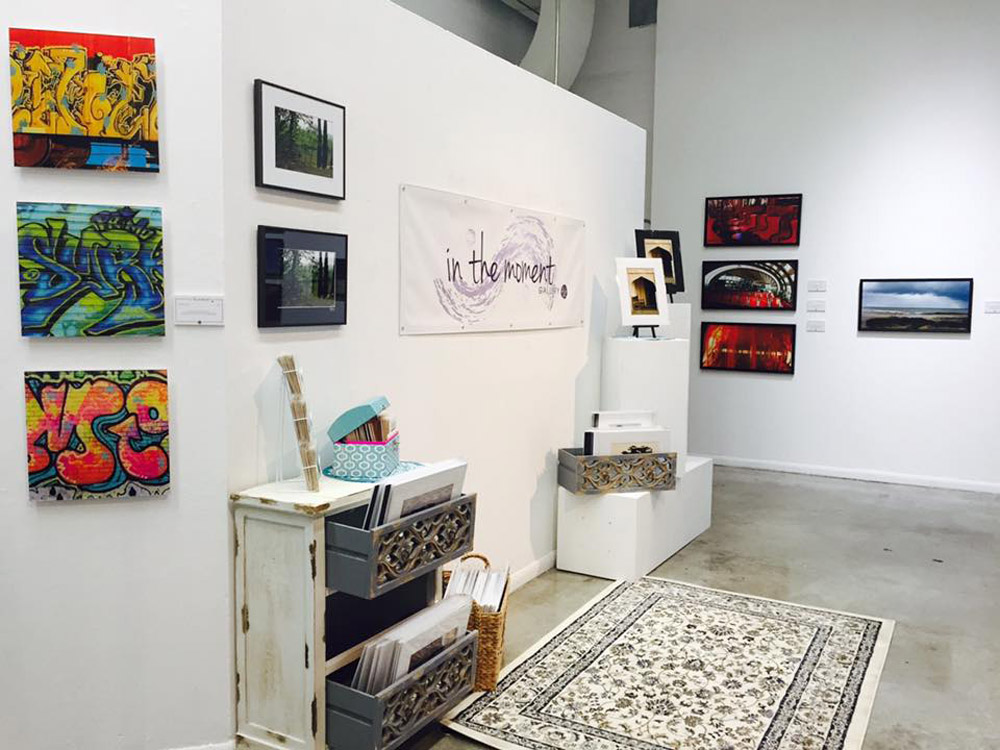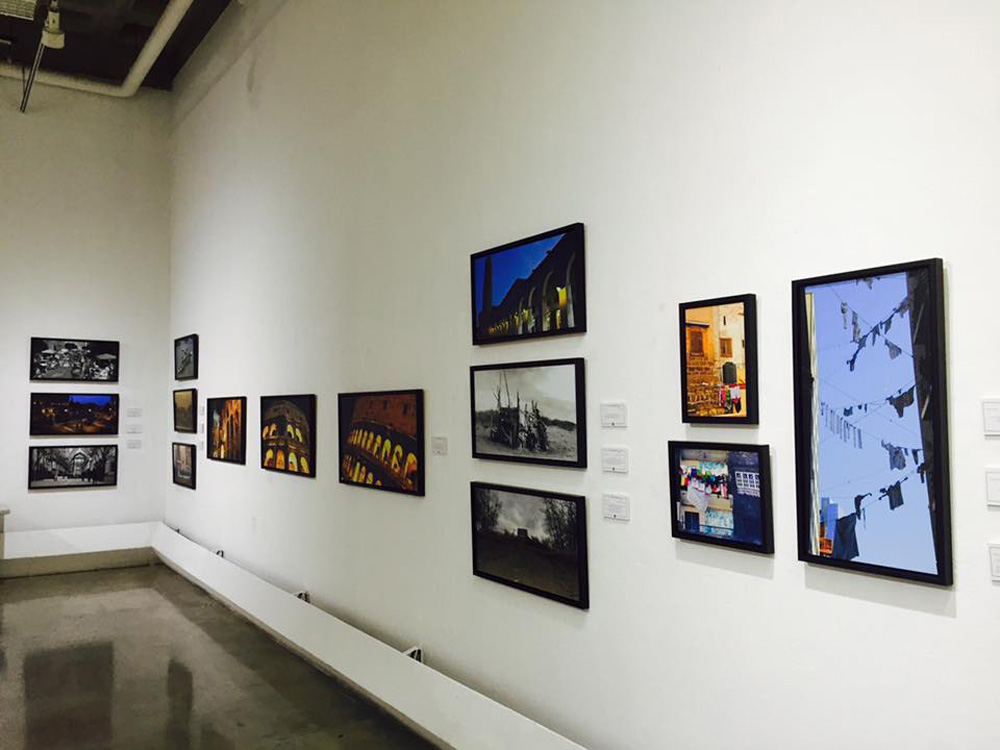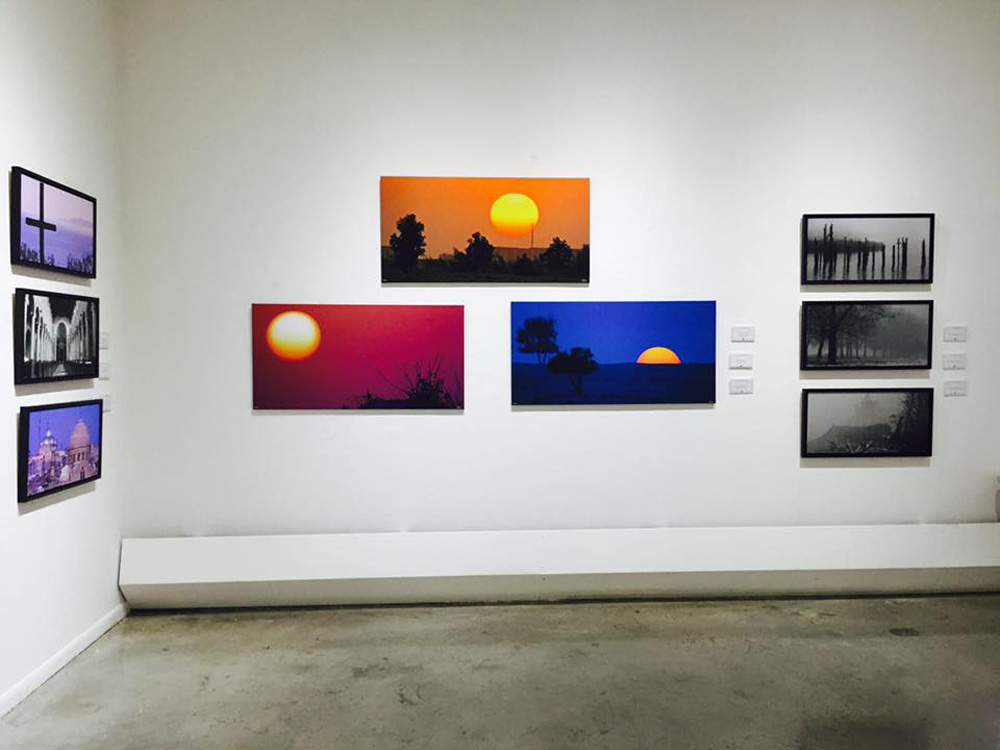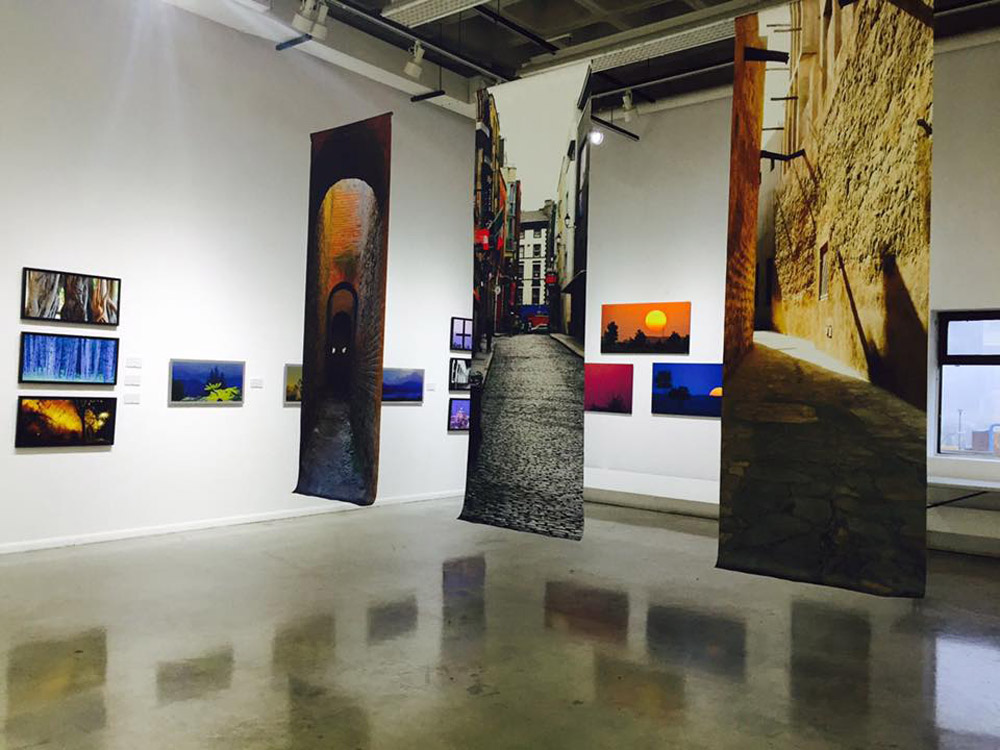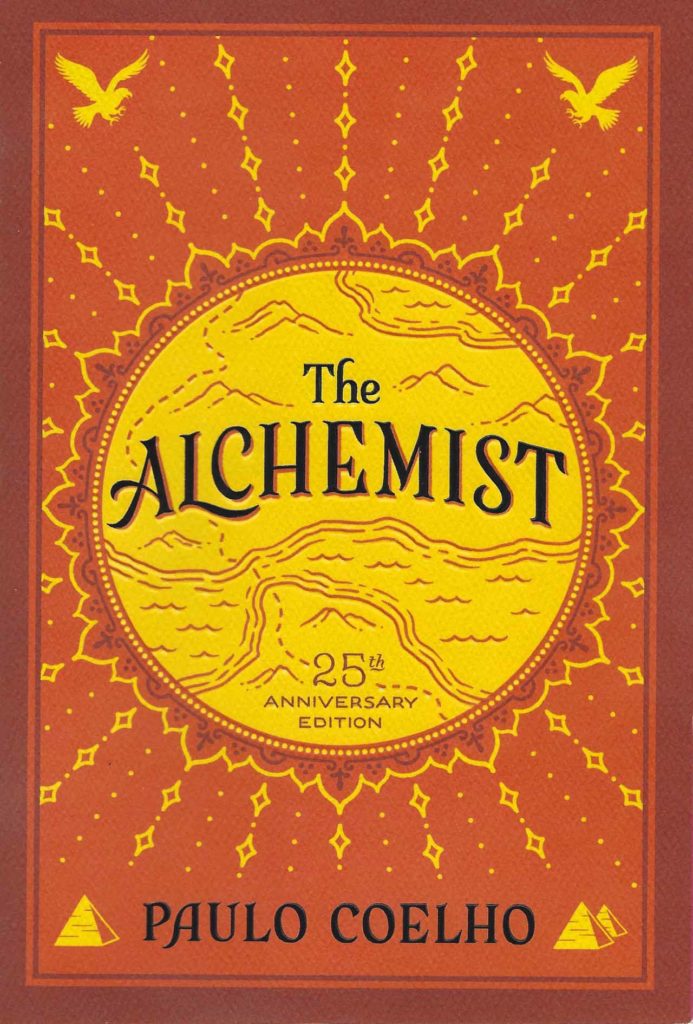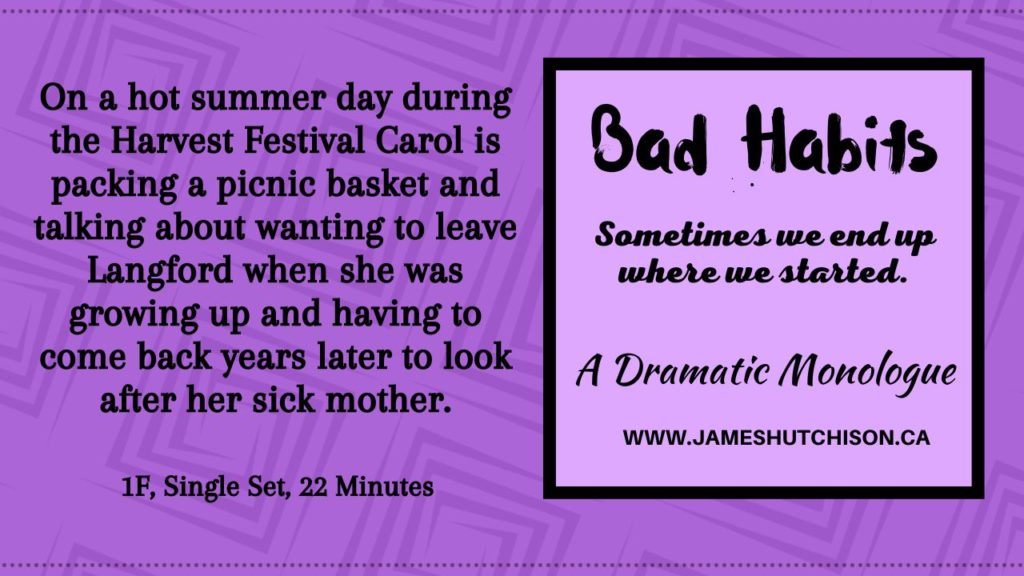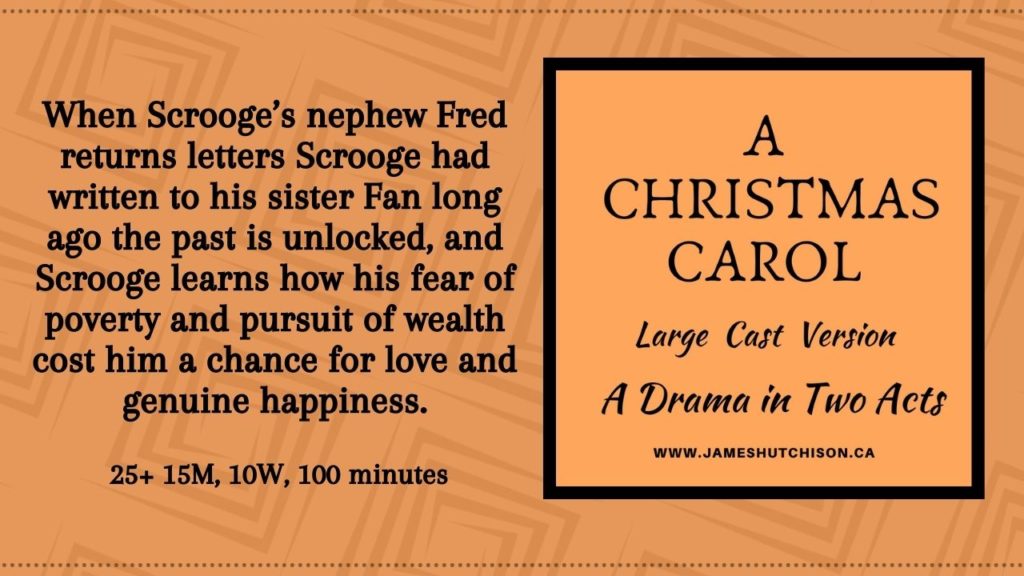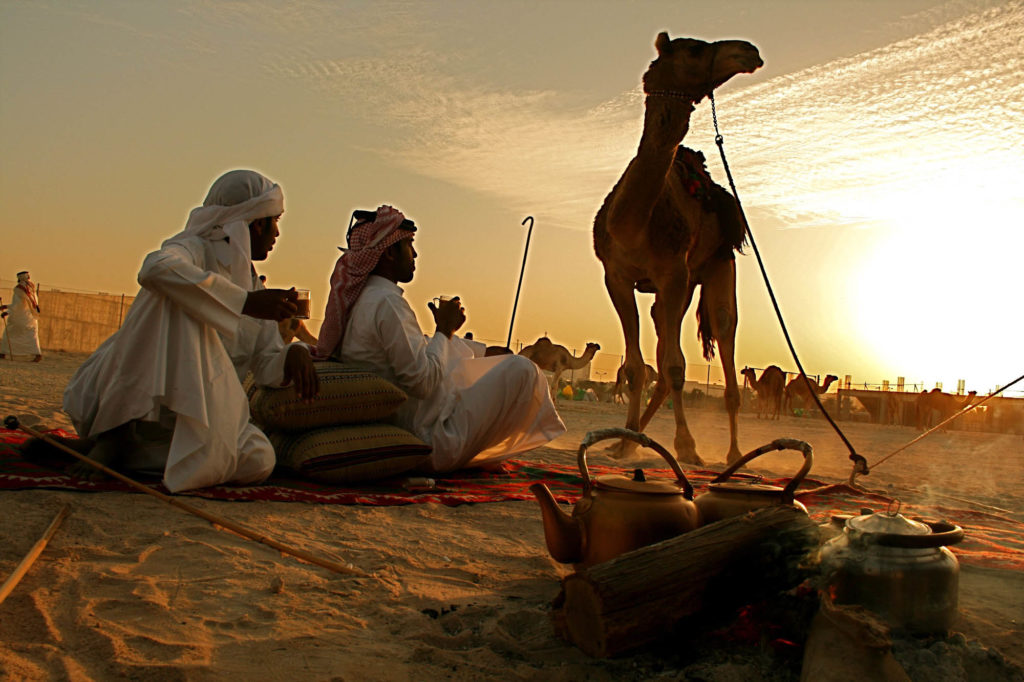
“I think gratitude is extremely critical. It is so easy to look at the negative side of a situation. Not to deter from the negative things that are going on in people’s lives – I respect that. And I understand that it can be difficult, but that attitude of gratitude that they talk about is magic. It changes your brain. It makes you always optimistic for what can happen, the possibilities, and it might not always work out – things don’t always work out as I planned them, but I never stop having that gratitude and that optimistic attitude, and I really do believe that carries you far. I believe the world gives you what you need when you keep giving the world what it’s asking of you.”
Louise Good
In the Moment Gallery
Louise Good has been travelling the world, camera in hand, taking photographs of her journeys and adventures for the last couple of decades. Over that time she’s created a body of work that is based primarily on what God gives her in the moment.
I contacted Louise last summer to talk with her about her interest and approach to photography where she told me about the key questions photographer Sam Abel asks about his work and how she now uses those questions as a guide for her work both past and present. We also chatted about one of her favourite books The Alchemist by Paulo Coelho, some of her views and thoughts about life, and what it was like growing up in a large family in the northern Alberta community of Grande Prairie.
LOUISE GOOD
Grande Prairie was a great community for our family. Lots of activities. Lots of involvement. As I got older, I played basketball in high school and in college. And I also did a lot of drama and acting. I did a lot of community theatre, and that was a great experience for me, and it kind of led me to my career choice, which was to go into broadcast journalism. And that’s where you and I know each other from because we both went to SAIT together.
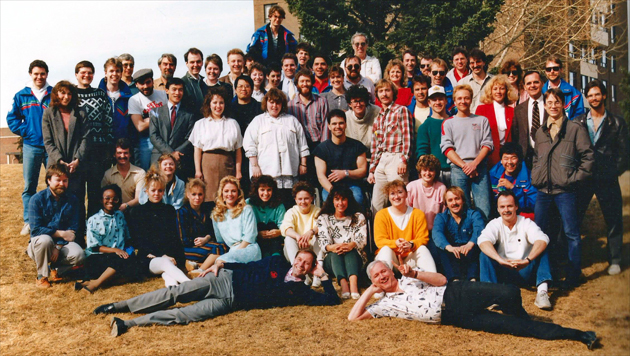
JAMES HUTCHISON
That’s true. You mentioned you played basketball growing up and in college, and sports have been a big part of your life. What do you think have been some of the lessons you’ve learned from participating in sports?
LOUISE
I’ve always had a competitive spirit. I think anyone who knows me would say that’s true. It partially comes from being the oldest in a family of nine kids. I had to be independent from a very young age, and sports really taught me how to channel that energy, how to excel, how to work hard, and to never give up, and never give in when things do get tough.
It also taught me a lot about collaborating and teamwork and other people’s points of view, and understanding that sometimes you take the lead, and sometimes you support the leader. So, I think I learned a lot from sports and possibly some of those skills I also learned from growing up in a big family as well.
JAMES
You mention growing up in a family of nine and the majority of us don’t have that sort of experience, but for you that was daily life. So, what is it like growing up in a large family like that and what have been some of the life lessons?
LOUISE
I think from a young age, we learned that we had to work together. And I was very fortunate and blessed to grow up in a family that was full of love. Our parents always instilled in us that we could achieve whatever we wanted to achieve. And I’m not saying we didn’t disagree as siblings and have our share of arguments, but we just had an environment where we could succeed, and we could fail, and it was still going to be okay. And I think that helps you to push the boundaries of who you are, and to help you support other people to be their best.
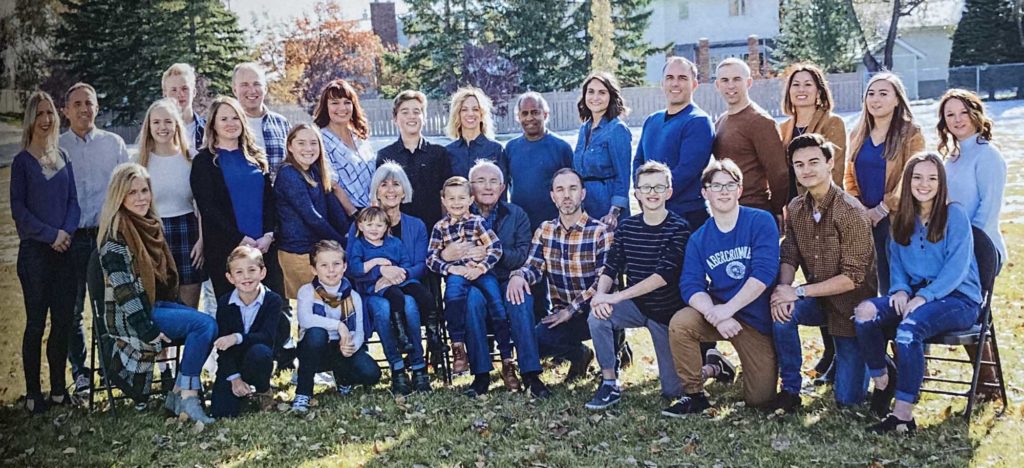
I don’t think you realize as a kid growing up that those are the life skills you’re learning, but as you get older, and you look back, you can see that some of your success was from that experience. And now that I’m older, I have a grown son. I have a granddaughter and lots of nieces and nephews, and we see that continuing into the next generation of our family.
And I know not everybody’s from a big family, but family has lots of different meanings in life. We create our own families. And friends become our family. I live in Houston now and because of COVID I haven’t been back to Canada to see my parents or the rest of my family in a year and a half. And so, here in Houston I have a family with my friends, and we support each other, and we help each other with our dreams and our goals, and my work family here is pretty amazing too.
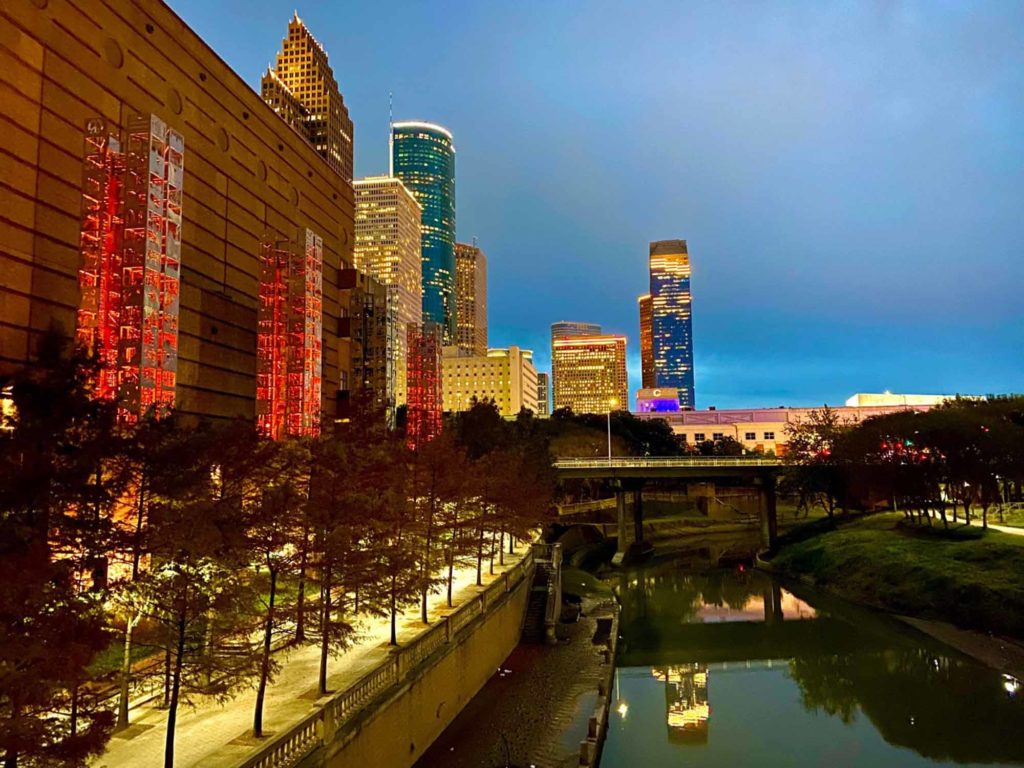
JAMES
What’s it like living in Houston?
LOUISE
I absolutely love Houston. It’s so welcoming. It’s so vibrant. There’s so much going on in Houston all the time. And there are also some similarities to Alberta because of the oil and gas industry. And of course, that’s the industry that I’ve worked in for a big part of my career. So, I’m very passionate about it. You have people from all over the world in Houston, which makes for great theatre, which makes for great sports. We’ve got all the professional sports, the ballet, the opera, and I’ve made some great friends here, and that makes all the difference in the world.
JAMES
You mentioned we met at the Southern Alberta Institute of Technology in the Cinema Television Stage and Radio Arts program. What made you want to report the news?
LOUISE
As well as being in drama I was also very active in debate. And I liked storytelling. And I liked sports. I actually saw myself, early on, as being a sports reporter. There weren’t a lot of women doing that at the time. But my career path sort of took a different route.
I started out doing broadcast journalism, and I loved it. I worked in radio. I had some television jobs. I did sports. I was my own camerawoman for a while and that’s where my interest in photography began. I had to learn about framing the image and how to make pictures come alive, whether it’s video or photos.
JAMES
What was the first camera you had?
LOUISE
My very first – what I would call a real camera – was a Canon Rebel. One of the very first brands of the Rebel that came out. That’s the camera I began more serious photography with, and that camera travelled all over the world with me. That’s the camera I had for part of my time when I was in the Middle East, and then I got the camera I have today. This one here. It’s a Canon EOS 60 D. And this one is not a new camera either, but it serves me well. The technology inside the camera hasn’t really changed a ton. And maybe some people would argue with me about that, but this is not the top-of-the-line pro camera.
JAMES
Honestly, I’m not that interested in the technical, I’m more interested in results. I got a book out of the library this week called The Americans. It’s a book from the ‘50s, and it’s a bunch of these candid photos that photographer Robert Frank took while on a road trip through the United States. And some of them are taken from bizarre angles and some are blurry, but they all have an emotional impact. There’s power in the image.
LOUISE
I like that statement. Emotional impact.
JAMES
I read this quote “Photography has nothing to do with cameras.” It’s by a guy named Lucas Gentry. I couldn’t find out anything more about him, but I was wondering how much do you agree with that idea or not? “Photography has nothing to do with cameras.”
LOUISE
I think that’s exactly what we’re talking about. It has nothing to do with cameras because anybody can take a great picture these days. Because what makes a great picture is that emotion that you’re talking about. A photo evokes a feeling in somebody, and it doesn’t matter what the camera is, and I know we have great photographers who do amazing technical work, but these days the technology is so good in a phone that a picture can be snapped by anybody.
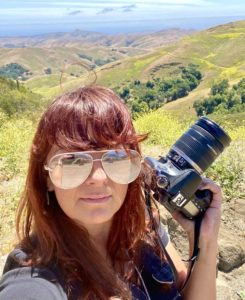
I saw one this morning. I was looking online. I think it was the CNN Pictures of the week. And it was a photo of this kid jumping into a pond beside a highway. And he was mid-air, and it was just an incredible picture. Now, technically, was it a good picture? Not necessarily, but I went back to that picture three times because it was so cool.
And this reminds me of something I want to talk about. I’ve heard the great photographer, Sam Abel, speak more than once, at the Professional Photographers of America Convention. He is an amazing photographer. And he has three questions that he asks himself about an image. Is it involving? Is it evolving? And does it stay? And so, I asked these questions to myself a lot now about the work I do and when you think about those three questions they kind of answer the other statement that photography has nothing to do with the camera.
After I heard him speak in 2011 I did a couple of things. First, I looked back at the work that I’d already done, and I asked myself why is that a good picture? Does it accomplish those three things? Because, generally speaking, if it’s a good photo, it already has accomplished those three things.
And I still don’t think you can plan to make that happen. Sometimes it’s very spontaneous. And Sam Abel spoke about how he plans out a picture. He frames the picture and then he waits, sometimes up to twelve hours to take the photo. And I thought to myself, “Oh Lord, I do not shoot that way. I don’t have time for that. I just shoot in the moment that God gives me. If it’s a rainy day or if it’s a sunny day I just go and see what I can get. That’s my style. It’s candid, and it’s proven to be very effective for me. Many of my pictures are truly shot in the moment.”
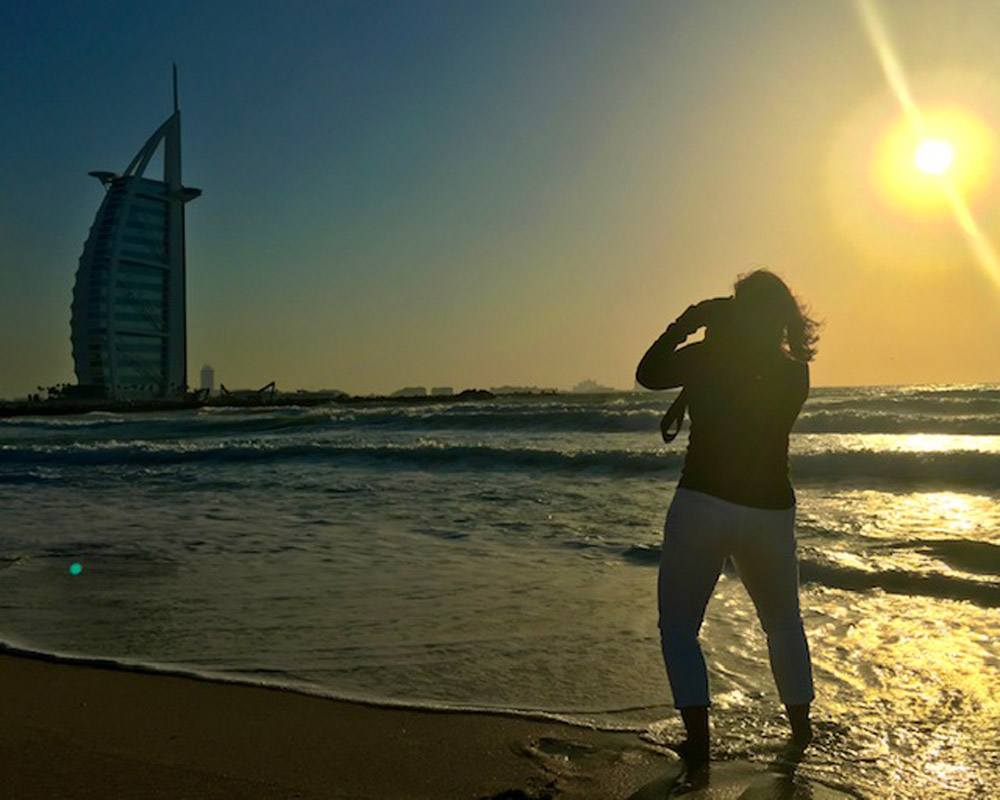
I didn’t say any of that out loud, obviously, because I was sitting in an auditorium, literally, but I knew that was the name of my brand – In the Moment.
The other fascinating thing is that when it comes to photography or art, as you well know, different things appeal to different people. So, a picture that I may love, for some reason, you may not like at all. And it’s always surprising to me when that emotion comes from a picture that I took or a print that I’ve made that I didn’t expect would evoke that emotion in me.
JAMES
You know, I was listening to a video from photographer Sean Tucker on YouTube and he was talking about the importance of going back and looking at and curating your old work because you have a better eye in the future looking back at your old stuff so you can pull out the work that you didn’t realize was good at the time.
LOUISE
That’s such an interesting perspective. Really makes me think when you’re talking about that. And maybe you know you can explain a little bit about this from your own body of work because sometimes when you go back and read your work again you see things differently and it’s not what you wanted, and that’s why you edit your work, right?
JAMES
Right.
LOUISE
Do you think that comes from a different perspective when you look backwards, or because your emotion isn’t as involved in that moment?
JAMES
It’s funny you mention that because I am working on a script that I wrote ten years ago. And I can’t write that same script today. I’m in a different place and the things I want to say in the script now are a lot different than what is currently said in the script. I don’t plan to change the time of the play. I plan to keep the time of the play in 2010 and oddly enough it’s the only play I’ve written that is about broadcasting.
It’s the one about Wildrose Radio. It’s about a morning show in Lethbridge. I wrote it and I let it sit for a long time and just this year started working on it again. But I’ve got over ten years of additional life experience and I want to comment more on how media and social media have evolved and what the world has been through. Plus, there’s tremendous comedy potential there since the characters will be speaking from their time frame in 2010 about what the future will be and what they think is going to happen and since the audience has lived through the last decade there will be great comic potential there plus an opportunity to evaluate how did we get here? How did we end up with such a polarized world? How did social media become so important?
I think you can’t help but be influenced by the life you’ve lived and the experience you’ve had. And it’s not just your personal experience. It’s also the culture and what the culture has been through, and I think that applies to story, and I think it applies to images. When you were talking about – is it involving, is it evolving, and does it stay with you I think that totally applies to a story, you know? Is a story involving and is there something happening? Is it progressing? And after the credits run, does it linger with you? And so, photography is really storytelling, right, and so I’m wondering how much do you think photography captures reality and how much do you think photography is an interpretation of reality?
LOUISE
That’s a tough one because I think it does both depending on the purpose of the image. In social media a lot of the images we see are people promoting themselves as a brand, and I don’t know how real any of that is, but then there’s a lot of authenticity in the world too, and those are the photographs that really capture people’s imagination. You know that picture of the boy diving into the pond that I looked at this morning.
So, why is it that all media has the top photos of the week? Why is it that even your local news has people sending in their images and people want to see them? It’s because it does represent moments in time, and I think those moments in time are really authentic and they do show us a piece of the world.
I’m working on a series right now called Storm. And I’m actually looking back at some of my older work as well as incorporating some recent work that I have. And the idea of doing a series in a show called Storm isn’t about the gloom and the darkness of a storm, but what comes out of the storm. The resilience. Joy. You know, rebirth. New life. A new perspective on the world and I think it really speaks to a lot of what we’ve gone through in the last year. We’ve been through so much change. Not just because of COVID and loss, but also the economies of the world, the storms they’ve been through, and there’s still great work that needs to be done on social justice issues. And all of these storms that we’re going through are creating something new, and hopefully something better.
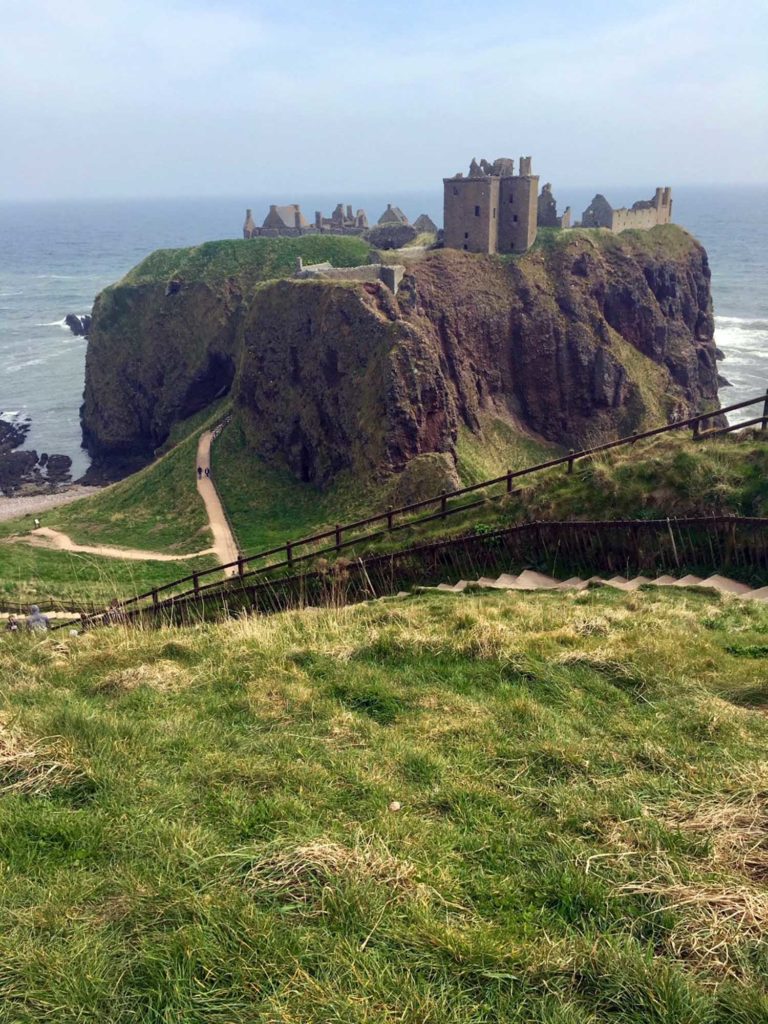
JAMES
You said you were going back and looking at past work as part of your work on this series called Storm, but then I’m wondering, how do you think, photography, and looking back at these old photos impacts our memory of the past?
LOUISE
Well, I find that many of the photos from my past make me smile. Even if they’re not comedic photos. And I think it goes back to those three questions. Is it involving? Is it evolving? And most important in this case, does it stay?
So, when you go back and you look at, like for example in 2019 before COVID I was doing some work overseas, and I was in Scotland, and I took a train out on the Sunday to this little town, and it’s near a castle called Dunnottar, and I went up through the town and up onto this hill to get to the castle – to walk along the sea. But when I turned back a storm was coming in over the town, and it was so dramatic. I was standing on this hillside. It was bright sunshine, and yet, in this town and around the valley it was dark, and I took all these pictures, and it was beautiful. And I was lost in that moment and when I looked back at those pictures recently, I could really be back in that moment.
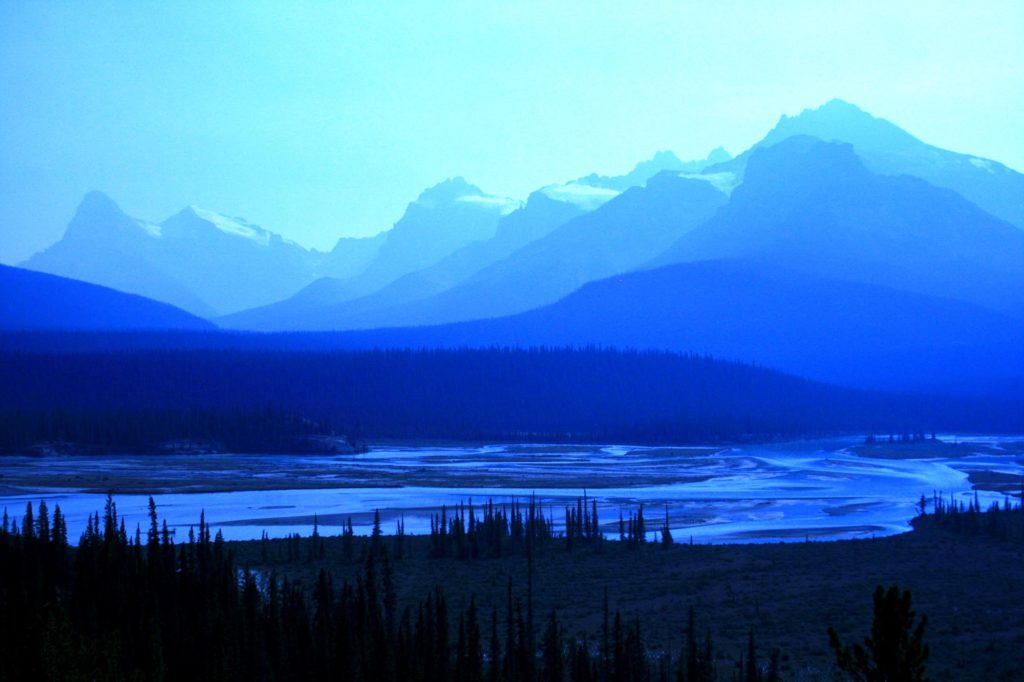
JAMES
Well, speaking of pictures that speak to you I asked you to provide five of your favourite photos so we could talk about them and the first photograph I have here is the mountain – the blue smoke – I think you call it.
LOUISE
I called that Smoke. This was a challenging task for me. To pick five pictures, and I really had more than five. And there are some I switched out based on my perspective on a particular day. So, these are the five, that I guess, I settled on.
JAMES
On July 17 these are the ones that you settled on. Tomorrow you might have changed it.
LOUISE
But interestingly, I do have a gallery of my favourites on my website that you can go and have a look at.
JAMES
Right. So, tell me about this photograph. Why is it one of your favourites and what’s the story behind it?
LOUISE
I took that photo on the highway between Banff, Alberta, Canada and Jasper, and there was a forest fire, and it was really smoky through the valley. The fire was actually in British Columbia but the smoke comes through the valley, and it just sticks there. So, I got out and I took some pictures. The only thing that I’ve done to that picture was I just emphasized the colours that were already there. All of those blue colours were what the picture gave me. I just saturated the picture a little more. Blues are a relaxing colour, and I just think it draws you in.
JAMES
The smoke almost acts like a filter. And in between the first mountain and your camera there’s less smoke and then there’s more smoke between the next ridge and your camera because there’s more smoke as you go farther back to each ridge and it actually creates this unique lighting event from the camera’s point of view.
LOUISE
The key element is layers. There are layers in that picture and so it’s involving because you go from layer, to layer, to layer, with your eyes. It draws you into that photo.
JAMES
It’s a beautiful photograph. Did you do this one in metal?
LOUISE
I did do this one in brushed metal and it’s really beautiful in brushed metal.

JAMES
The next photo I have is the two guys and the camel and the pots down in the bottom right. Tell me about this one.
LOUISE
So, I was living in Doha, Qatar, and it was Qatar National Day, and I was out with my camera, and this group of men riding camels down the street came along, and so I pulled over and I waved, and I asked if I could take some pictures. And they told me to take pictures, and then they invited me back for tea at the Bedouin camp. Now, normally a woman would not be invited to the tents. That’s for the men. The men do that together, but because this was a special set up so that people could come and see what a traditional Bedouin camp looked like they invited me in.
It was near the end of the day and, you know, technically speaking, somebody might say that picture is not perfect because I didn’t capture the light exactly right in the sky, but emotionally speaking you can have no argument that that is a great picture. And especially if you live in that part of the world. You know again it’s another one of those that might not have meaning to somebody who’s never lived in the Middle East, but it’s a beautiful, beautiful part of the country. And so, we were sitting around the fire. We had the tea, and I just took that picture, and the camel was there, and the young guys were looking at the camel.

JAMES
The next one I have is the Radio City Music Hall in New York City. And it’s a rainy night. Tell me about that.
LOUISE
I took this picture with my iPhone. Not with my camera. I didn’t have my camera with me because it was raining so hard. It was my very first trip to New York, which was only two years ago. I’ve travelled all over the world, and I’ve never been to New York, and I just decided that when the time was right the world would let me know that it was time to go to New York.
And so, I found myself in New York with a couple of friends. But on that particular night, we were all doing something different. I wanted to go to the theatre and someone else was meeting a friend and somebody else went shopping. And so I was walking back to the hotel and it was just pouring, pouring rain, and the streets were so wet, but it was so alive, it was just so what New York is – even in the rain. You could feel the excitement. Other people might think it’s average or it doesn’t do anything for them but since I’m picking my favourites I think it’s really cool. And, technically, it’s a storm.

JAMES
That’s true. Okay, so the next one I’ve got is the one from Louisiana, Into the Mist, I think you called it. That’s the one with the shadow trees. It’s a striking image. Tell me about that.
LOUISE
This is an image that has evoked the most emotion in others, as well as for me. I posted a version of this on my social media, and I had a lot of responses, and a couple of people even wanted to purchase the picture, so I made a couple sales.
This is the Atchafalaya Swamp in Louisiana, and this was taken during my first road trip after I moved to Houston. I was driving to Nashville to attend the Professional Photographers of America Convention, and I decided to drive there because I really wanted to take my camera and go on an excursion. And so, it was early morning, and I was coming across this part of the highway, and the fog was just thick in the swamp area, and it was just stunning to me. Spectacular.
And you’re not really supposed to stop along that part of the highway but there was a work truck there, and he had his lights flashing and there was room. So, I took the opportunity to pull in front of his vehicle where it was safe, and I got out, and I took as many pictures as I could. That picture is spooky. It’s definitely involving, evolving and it definitely stays with you after you’ve looked at it. How do you feel when you look at that image? Do you like it or not like it?
JAMES
I like it a great deal. It almost feels like a painting to me. And I like the abstract nature of it. I love photographs of trees. It has a surreal feel to it. And yet, it’s part of the world. It’s part of nature. At this moment in time when you were there this little image appeared and this is a part of the world.
LOUISE
If you really think about it, that picture didn’t stay that way for very long. It’s a true In the Moment photo. And I have been across that highway, many times since then. For work, and other reasons. And I have never ever seen it like this since. No matter what the time of day or the time of year. So, it’s unique and it really draws you in. And I actually had written some notes about this photo and I call it a surreal image which is exactly what you said.
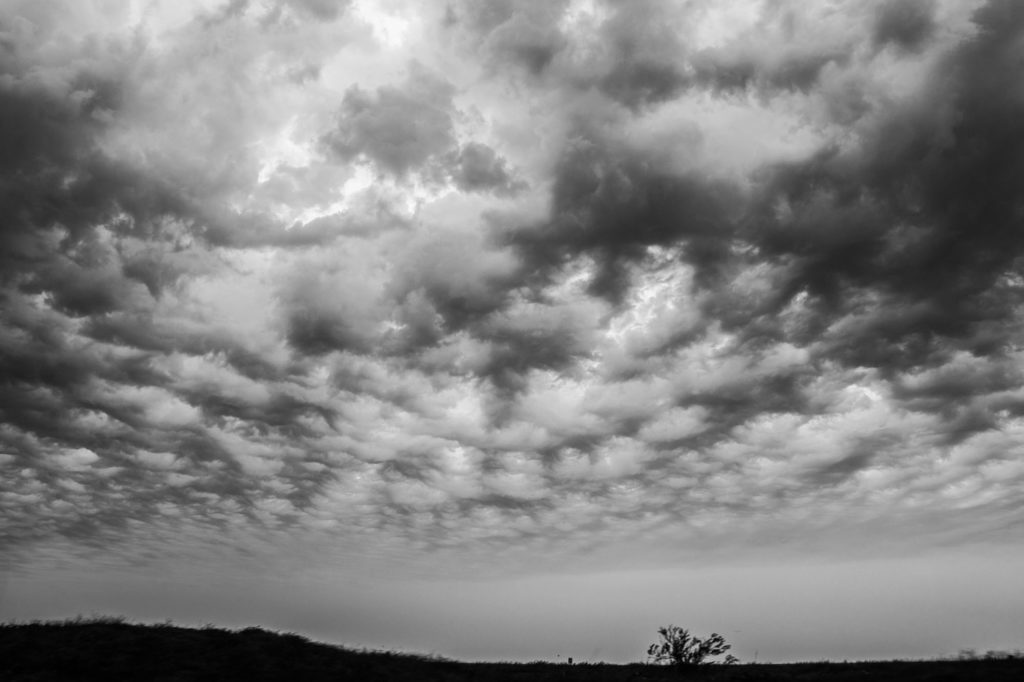
JAMES
So, tell me about this one. The storm clouds. It looks like it was shot at a beach, or on the prairie.
LOUISE
That’s at the beach over the Gulf of Mexico between Galveston and Lake Jackson. That was shot during COVID when everything was on lockdown. So really the only thing you could do is go for a drive, which suited me just fine because I can take my camera and go. And this particular day the clouds were just rolling in. I have a bunch of different images from this day, and the one I picked to show you is a black and white. And I just think this one is dramatic. That’s my word for it.
And so this will also be a part of the Storm series because of when it was taken and also because I feel this picture is almost overwhelming emotionally which is how you feel when you’re going through a storm in life. There’s a lot of unknowns going on but eventually, those clouds are going to roll back, and you’ll experience that peace that comes when a storm passes because you gain understanding.
JAMES
Back in 2016 you arranged for a photo exhibition at the Alberta College of Art and I wanted to talk a little bit about that show. What was the process like for putting that show together?
LOUISE
My theme for that show was contrasts because there was so much contrast in my life at that time and there was so much contrast in the images that I had. I had all these great pictures like the Smoke picture from Canada, and the camel picture from the Middle East and the question is how do you take those two diverse images and make a show that people can follow. And so that’s how Contrasts was born.
I grouped pictures together. I had groups of three different pictures under a common theme, and I used different mediums. So, some of them I put on canvas. Some of them I put on brushed metal. And there was a lot of work that went into that. Picking the pictures. Writing the stories. I had a lot of help from friends and family, and really it was a labour of love, and it was a success.
JAMES
When you had everything set up including these twenty-foot tapestries hanging from the ceiling in the middle of the room and you had some big photos on the walls what was it like walking into that room after it was all set up and seeing a representation of your work being displayed in a show?
LOUISE
It was very humbling to see it all. I also had so much gratitude for the experiences I’d had that made it possible to take those images and put together this show, and I also had a great sense of accomplishment for a story that I was sharing partly about myself and partly about a body of work that I’d created.
JAMES
You mentioned gratitude. And I’ve known you a long time, and gratitude is a word that comes up quite often with you. How important do you think gratitude is in terms of life?
LOUISE
I think gratitude is extremely critical. It is so easy to look at the negative side of a situation. Not to deter from the negative things that are going on in people’s lives – I respect that. And I understand that it can be difficult, but that attitude of gratitude that they talk about is magic. It changes your brain. It makes you always optimistic for what can happen, the possibilities, and it might not always work out – things don’t always work out as I planned them, but I never stop having that gratitude and that optimistic attitude, and I really do believe that carries you far. I believe the world gives you what you need when you keep giving the world what it’s asking of you.

JAMES
So how much do you think your life has been planned and how much do you think your life has been unplanned?
LOUISE
I guess it depends on your perspective but from my perspective, I’m a woman of faith. So, I have to believe that my whole life has been planned – divinely planned in some aspect. And I know that not everybody has those same views, but those are my views, and I think that has helped me to define my strengths and some of my success, and also keeps me honest about what I need to continue to improve upon myself because I can be a very strong personality.
And I think that I have to focus on that attitude of gratitude and appreciation of people and helping others. I like to think that I live a life of service. And so much of the work that I’ve done in my entire life, in my career has been really in the service of others. And my background is a lot of sales work and sales leadership, and for me, sales is about a life of service because it’s not about selling a widget to somebody. It’s about the relationship around those transactions and what we do to ensure that there’s service around the relationship around the business transaction and that those are lifelong endeavours.
JAMES
The Alchemist is one of your favourite books.
LOUISE
Yes, it is.
JAMES
When was the first time you read it, and what did you think about it, and why has it become a favourite book of yours?
LOUISE
Okay, well, you gave me a copy of The Alchemist, my friend. That is when I got my first copy and I’d say that was maybe ten years ago.
JAMES
Sounds right.
LOUISE
You had read the book and talked highly of it, and so when you gifted me that book, it just really spoke to my soul. There are just so many parts of that story that resonate with a lot of people. One of the things that it talks about in the book is when you’re following your personal legend, the world gives you what you need.
What that means is when your soul is on its path – when you’re giving to the world in the way that you’re supposed to – it’s amazing what the world gives back to you. There are also some biblical principles around that because Paulo Coelho is a man of faith.
But the second thing I love about The Alchemist is the author’s story. Paulo Coelho wrote that book, and it was published in Spanish. And I think he said he sold three copies and two were to the same person. And that publisher cut him free, but he never lost faith in his book. So, when nobody else could see that there was something there, he still believed. And that, I think, is such an important concept in the world today – don’t give up on your dreams. Don’t let anybody tell you that your dream isn’t your dream and that it’s not important.
And he says, “I was following my personal legend and my capacity to write, was my treasure, and I needed to share that with the world.” So can you imagine if this man had stopped at that point, because he didn’t get validation from the world? But he didn’t stop. He kept going. And now, The Alchemist has sold over 65 million copies.
I think that the thing I love most about this book – it gets in your heart and soul – it’s a part of you. First of all, don’t quit. Don’t stop. Keep going. The world’s going to give you what you need. People will show up to help you, because you’re following your path. And so often we stop. We quit. We give up. And as long as you’re alive, as long as you’re living, as long as you have a breath in you – keep going. Keep being your best and loving your life and giving to the world. That’s what I get out of this book.
And I have the book right here and I just want to read an excerpt from the introduction by Paulo Coelho in his own words. He says, “I re-read The Alchemist regularly and every time I do I experienced the same sensations I felt when I wrote. And here is what I feel, I feel happiness, because it is all of me, and all of you simultaneously. I feel happiness, too, because I know I can never be alone. Wherever I go, people understand me. They understand my soul. This gives me hope.”
And I just really personally relate to that statement so much because I think that’s how I speak through my own art. It really is my soul, and it really does give me hope that the world is a great place because we can find union in art and in the world and in common ground.
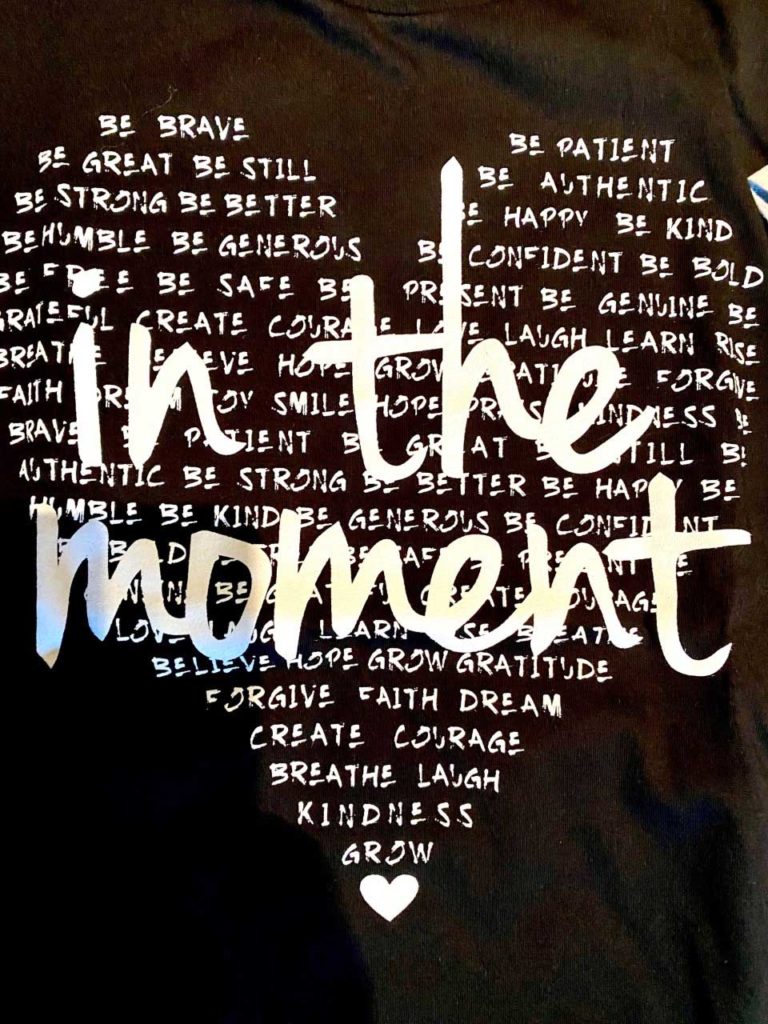
JAMES
I want to talk about, In the Moment. You originally picked In the Moment to promote your photography and then you had an epiphany, I think, it was last summer and now you want to take the idea of In the Moment and make it more than just about photography. Can you talk a little bit about your vision for In the Moment and what you see the future being?
LOUISE
I think it was probably about halfway through last year. It was a month or so into COVID, and I began to have this vision for In the Moment – the brand – that there was a time and a place for this to make a difference in the world. And so, I realized that when the world had to stop because everything shut down, I mean literally everything shut down, people had to take a look at themselves.
And it allowed us the opportunity to be in the moment. To be more present. We weren’t rushing around. And so, it sort of came from my soul and I started designing and working on incorporating some of my images and different words to go with the In the Moment brand.
Be brave in the moment. Forgive in the moment. Rise in the moment. There are so many words that you can use. Laugh in the moment. Be better in the moment. And that’s my vision. To make a difference in the world. To make the world a better place through my photography and through my In the Moment Gallery and to evoke gratitude and kindness, love and grace under difficult circumstances.
JAMES
In what way, if any, do you think the experience of COVID could possibly be a positive thing.
LOUISE
Well, I don’t want us to forget the power of just being still. The power of shifting your values back to family, to friends, to simplifying your life, and to not forgetting – what’s most important to you and prioritizing your values. I think a lot of what in the moment means to me is being creative, being innovative, and thinking about the possibilities that COVID allowed for you that may not have happened otherwise. And I know that there is a lot of anguish and sadness and devastation that’s come from this period of time as well. And certainly, I acknowledge that, but once we get through this storm and we’ve survived it then we have to ask, “What can we do to make an impact on the world? What can we do to make this world a better place?”
